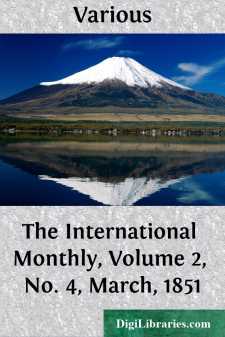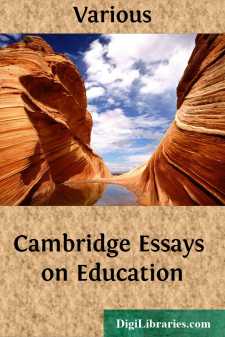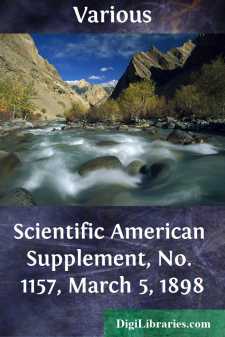Categories
- Antiques & Collectibles 13
- Architecture 36
- Art 48
- Bibles 22
- Biography & Autobiography 813
- Body, Mind & Spirit 142
- Business & Economics 28
- Children's Books 14
- Children's Fiction 11
- Computers 4
- Cooking 94
- Crafts & Hobbies 4
- Drama 346
- Education 46
- Family & Relationships 57
- Fiction 11829
- Games 19
- Gardening 17
- Health & Fitness 34
- History 1377
- House & Home 1
- Humor 147
- Juvenile Fiction 1873
- Juvenile Nonfiction 202
- Language Arts & Disciplines 88
- Law 16
- Literary Collections 686
- Literary Criticism 179
- Mathematics 13
- Medical 41
- Music 40
- Nature 179
- Non-Classifiable 1768
- Performing Arts 7
- Periodicals 1453
- Philosophy 64
- Photography 2
- Poetry 896
- Political Science 203
- Psychology 42
- Reference 154
- Religion 513
- Science 126
- Self-Help 84
- Social Science 81
- Sports & Recreation 34
- Study Aids 3
- Technology & Engineering 59
- Transportation 23
- Travel 463
- True Crime 29
The International Monthly, Volume 2, No. 4, March, 1851
by: Various
Categories:
Description:
Excerpt
AUSTEN HENRY LAYARD, LL. D.
In an early number of the International we had the satisfaction of printing an original and very interesting letter from Dr. Layard, in which, with more fulness and explicitness than in his great work on Nineveh, he discusses the subject of Ancient Art. We have carefully noted from time to time his proceedings in the East, and our readers will remember that we recently gave engravings of the most remarkable of the antiquities he sent home last year to the British Museum. Since that time he has proceeded to Bagdad, and he is now pursuing in that vicinity, with his wonted sagacity and earnestness, researches for the remains of Babylon, which in turn will furnish material for another extensive publication from his pen.
The first public announcement of the discoveries at Nimroud was made in the Knickerbocker Magazine of this city, in a letter from our countryman, Minor K. Kellogg, the painter, who was a long time the intimate friend and travelling companion of Layard in Asia Minor. Introducing the letters in which the antiquary disclosed the successful result of his investigations, Mr. Kellogg says:
"I can scarcely call to mind a person so admirably qualified in all respects for prosecuting such laborious researches. He is young, of a hardy and enduring constitution, is acquainted with the Oriental languages, and speaks the Persian and Turkish fluently. He is enthusiastic and indefatigable in every thing he undertakes, and plentifully endowed with courage, prudence, and good-nature."
This was more than two years before Layard himself, in his "Nineveh and its Remains," exhibited those triumphs of his intelligence and devotion which have secured for him a place among the most famous travellers and antiquaries in the world.
We take the occasion of copying the above portrait from the last number of Bentley's Miscellany to present, from various authentic sources, a brief sketch of Dr. Layard's history. He is descended from the noble French Protestant family of Raymond de Layarde, who accompanied the Prince of Orange into England. He was born at Paris, during a temporary visit of his parents to that metropolis, on the 5th of March, 1817. His father, who was the son of the Rev. Dr. Henry Peter John Layard, Dean of Bristol, filled a high civil office in Ceylon, between the years 1820 and 1830, and took great interest in the circulation of the Scriptures among heathen nations. He was a man of considerable classical learning, and of refined tastes. During the youth of his son, he lived at Florence, where our young antiquary had free access to the stores of the Pitti Palace, and of the Tribune. He thus became familiar from his infancy with the language of Tuscany, and formed his taste for the fine arts and literature upon the models of painting and sculpture amid which he lived, and in the rich libraries which he frequented. In this manner he added a thorough knowledge of modern languages to a competent acquaintance with those of Greece and Rome. Here, also, he acquired, almost involuntarily, a power over his pencil, which, long dormant, was called forth by the sight of slabs with the noblest sculptures and the finest inscriptions, crumbling into dust. No draughtsman had been provided for his assistance, and had he not instantly determined to arrest by the quickness of his eye, and the skill thus acquired, improved subsequently by Mr. Kellogg's companionship, those fleeting forms which were about to disappear for ever, many of the finest remains of ancient art would have been irrecoverably lost.
On his return from Italy to England, he was urged to choose the profession of the law; but his thirst for knowledge, his love of adventure, and his foreign tastes and habits, led him, after a brief apprenticeship, to travel. He left England, with no very definite object, in the summer of 1839, and, accompanied by a friend, visited Russia and other northern countries, and afterward, living some time in Germany and the states on the Danube, made himself master of the German language, and of several of the dialects of Transylvania. From Dalmatia he passed into Montenegro, where he remained a considerable time, assisting an able and active young chief in ameliorating the condition of his semi-barbarous subjects. Travelling through Albania and Romelia, where he met with numerous adventures, he arrived at Constantinople, about the end of 1839. Here he made arrangements for visiting Asia Minor, and other countries in the East, where he spent some years, adopting the costume and leading the life of an Arab of the Desert, and acquiring a thorough knowledge of the manners and languages of Turkey and Arabia. In 1840 or 1841, he transmitted to the Royal Geographical Society, an Itinerary from Constantinople to Aleppo, which does not seem to have been published; but in the eleventh volume of the Journal of that Society, we have an account of the tour which he performed with Mr. Ainsworth, in April, 1840....












